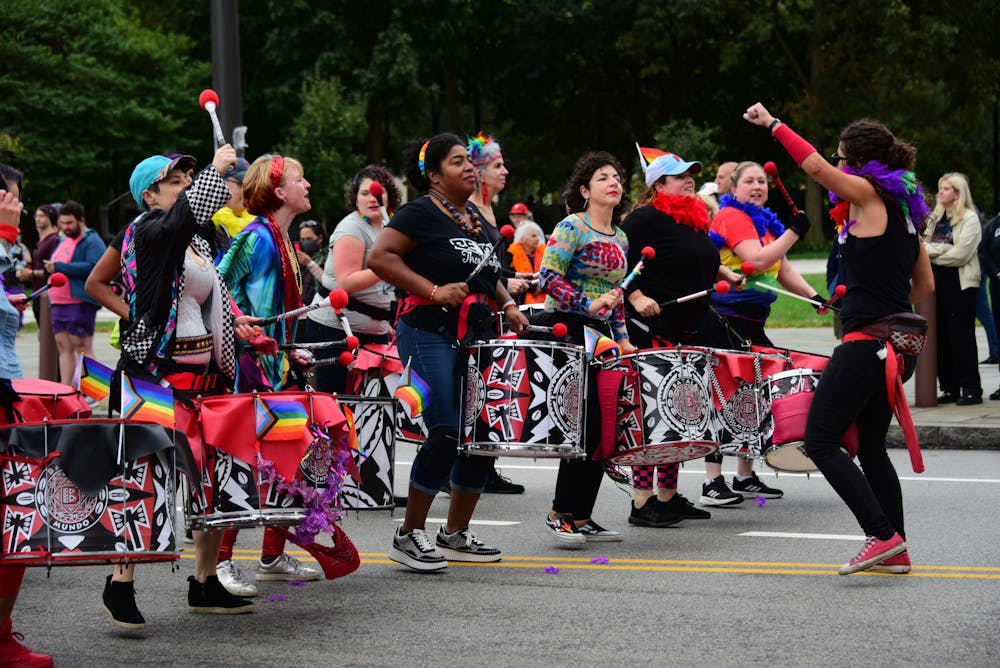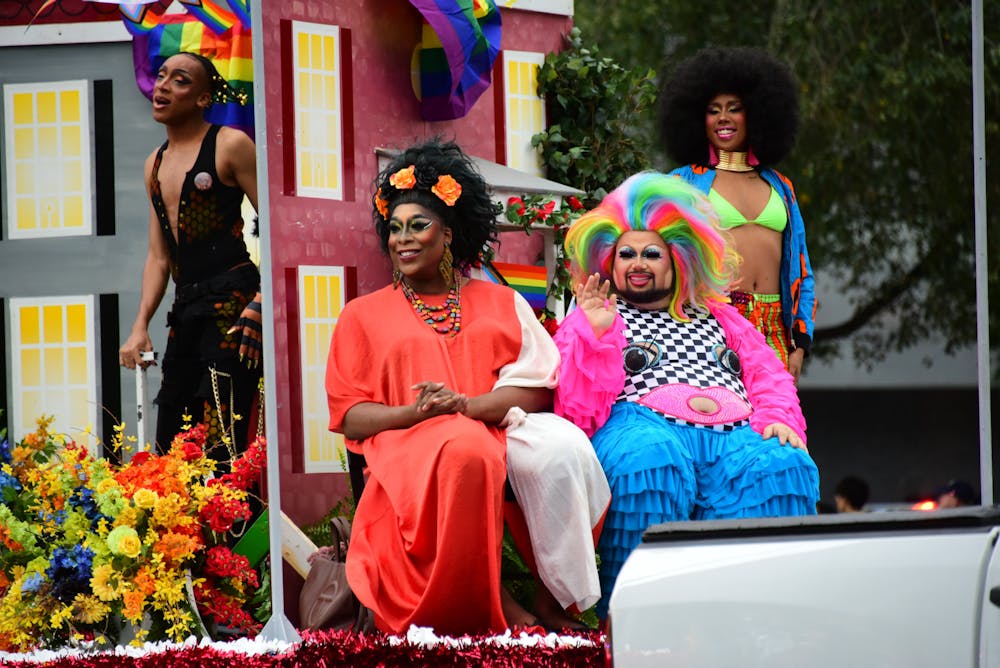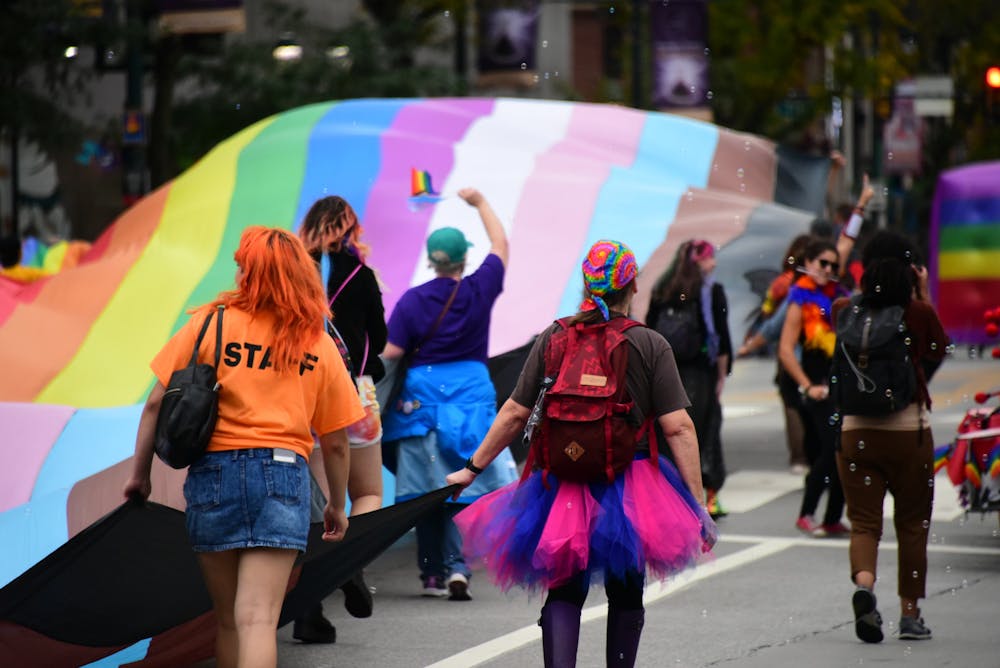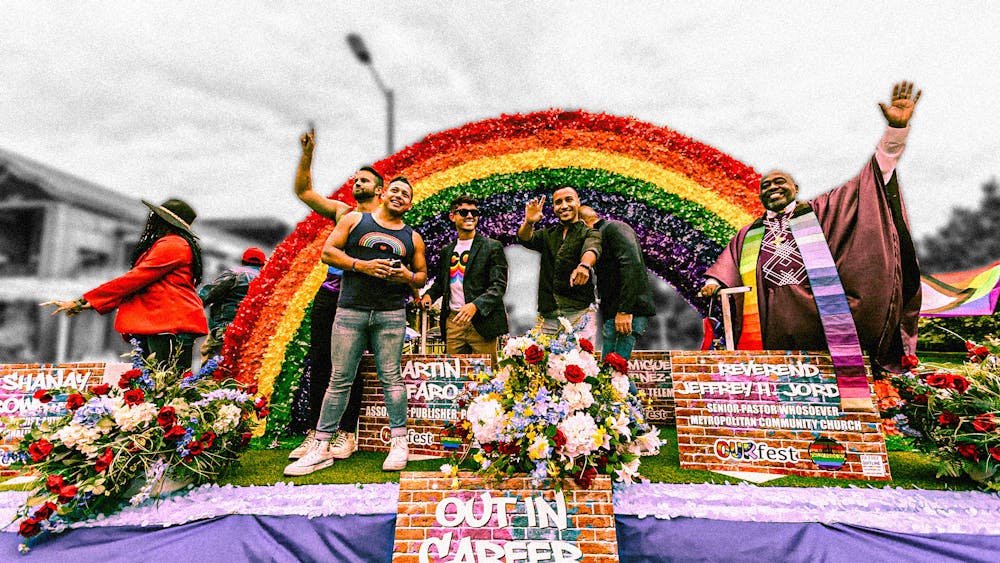In the Victorian era, “coming out day” evoked a stifling image of gloved upper–class girls lined up and formally presented to high society. Today, the term means something else entirely—sharing part of your identity with family and friends, rowdy street celebrations, and boisterous declarations of love. Nonetheless, some members of the LGBTQ community still see a thread of resemblance between the daunting rush of declaring one’s sexuality and the now archaic debutante, terrified and forcibly exposed to the world.
National Coming Out Day takes place annually on Oct. 11. This year, Philadelphia hosted the first parade in the United States to commemorate its observation. The event, called OURfest, culminated in a three–day festival from Friday to Sunday, including activities throughout the Gayborhood and a march from Fifth and Market streets to Broad and Locust streets.

Credit: Chenyao Liu
Despite its new public–facing revelry, National Coming Out Day has roots stretching back to 1988. Founded by Jean O’Leary and Robert Eichberg, who chose the date to commemorate the Second National March on Washington for Lesbian and Gay Rights, National Coming Out Day was a response to Reagan–era anti–LGBTQ rhetoric. Eichberg believed it was imperative for gay people to come out in order to dismantle misconceptions about the LGBTQ community. However, this sentiment has raised concern and anxiety for LGBTQ individuals with historically marginalized identities.
Tyrell Brown understands the importance of centering LGBTQ people pushed to the margins. As the executive director of the social justice organization GALAEI, they oversee services explicitly tailored to LGBTQ people of color living in Pennsylvania.
This year, Brown took on the responsibility of organizing OURfest, while also maintaining around–the–clock services such as housing linkages and grocery assistance for people in the community. Their office space reflects their love for Philadelphia’s multifaceted community—hand–drawn postcards, a shirt with the pride flag in the shape of Philadelphia, and a rainbow design of the LOVE Statue adorn their bulletin board.
They explain that Philadelphia’s story is one of resilience, much like queer narratives of perseverance in the face of adversity. The name “OURfest,” which stands for Our Uniting Resilience, honors endurance at the intersection of collective socioeconomic and queer struggles. “Every single day when we wake up and step out the door, we are expressing our authentic selves,” Brown says. “We don’t get a chance to talk about the resilience of that.”
Between coordinating organizations and funding, the added task of executing OURfest is a heavy weight to shoulder. However, Brown looked forward to seeing their community come together and share tender moments.
At the parade, crowds shiver in trench coats, and the clouds stir themselves into incipient showers. From across the rain–streaked street, one of the festival–goers, Grace Clark, cheers and jumps for passing floats, sending her frog earrings bouncing perilously in the air. Her grin seems to prove that Brown’s efforts have paid off.

Credit: Chenyao Liu
Clark says OURfest is particularly significant because it’s her first pride event. Having grown up in a conservative small town, she rejoices in Philadelphia’s inclusivity and is thrilled to find a space where queerness is outwardly celebrated. “Seeing so many loving people just be together makes me so happy,” she says. Although the glossier aspects of National Coming Out Day festivities are euphoric, like waving Philadelphia’s largest pride flag and harmonizing to “Dancing Queen,” the core of the celebration is the feeling of unifying solidarity.
However, for others, National Coming Out Day doesn’t always mean seamlessly finding and establishing a community. It requires considering complicated social and familial repercussions that accompany coming out.
Peter Lee (W ‘24), a member of Penn’s swimming and diving team, says that navigating queerness can be particularly difficult for athletes due to traditional ideas of masculinity in sports. Because gay men are often stereotyped as effeminate, queerness is often seen as being incompatible with athletic performance. “College athletics is very heteronormative,” Peter says. “You can imagine what the locker room situation is like.” He adds that coming out has different, and often dangerous, ramifications for athletes who risk attaching their faces, professional names, and even teammates to heated debates.
During Peter’s second year, Penn’s swimming and diving team became a beacon of news coverage when Lia Thomas, a transgender swimmer, joined the 2021–22 women’s team and became the first openly transgender athlete to win an NCAA Division I national championship. Thomas’s participation on the team incited heated public debate, prompting World Aquatics to bar all transgender athletes from competing in women’s swimming, except for those who “have not experienced any part of male puberty beyond Tanner Stage 2 or before age 12.”
Scrutiny also came from within. In February 2022, 16 anonymous members of the women's swimming and diving team sent a letter to the University and declared that Thomas should not be allowed to compete. “The behaviors from members of our team and the people involved did not sit right with me at all,” Peter says. The following year, Peter started Penn Athlete Ally, an advocacy group that strives to create community and fight for LGBTQ inclusivity in athletic spaces.
As a senior, Peter’s goal for Penn Athlete Ally is to lay down the base for a sustainable and long–lasting organization. In doing so, he wants LGBTQ athletes to know that people are willing to listen to, support, and lobby for them. “I didn’t have anyone,” Peter admits, referencing his first years at Penn, “and I don’t want others to go through the same experience.”
For students who are still in the process of developing connections in the LGBTQ community, Peter emphasizes prioritizing safety, urging student–athletes to come out at their own pace. He notes that there’s been a push in recent years to “always be yourself”—a notion that Peter doesn’t necessarily agree with. “Sometimes you just can’t be yourself,” he says. “People don’t realize there are so many barriers to doing that.”
Aubrey Shi (C ‘25), a board member of Penn Queer and Asian, agrees that being open about your identity isn’t always safe or possible in all situations. Aubrey says that for herself and many of her queer Asian friends, there’s a tacit agreement to avoid discussing their sexuality with their parents, which has less to do with conservative political values and more to do with cultural norms.
Aubrey points out that LGBTQ terminology may be second nature to us, but it can be difficult to grasp for immigrant parents whose first language differs from their children’s. “I feel like it'd be a very selfish decision for me to [make], because the only way that I would do it is to make myself feel better and feel more authentic,” she says. Coming out would primarily be a source of anxiety for her parents, and Aubrey notes that her mother would likely fear she wouldn’t be taken care of without a traditional family unit to fall back on.
Since they’re less likely to turn to their parents for support in navigating their sexuality, some Asian students have joined groups like Penn Queer and Asian to find opportunities for dialogue. The organization recently launched a mentorship program called M&m (a reference to the candies with big M's as mentors and little m's as mentees), which offers one–on–one sessions for students to discuss struggles faced by queer Asian people.
Aubrey feels that the queer Asian experience goes against the grain of Eurocentric coming–out tropes. When she watched a series of TikToks of people coming out to their parents in celebration of National Coming Out Day last year, she found that the majority of the videos were made by conventionally attractive white content creators who used similar language for their coming out speeches. She also noticed that most of their parents were overwhelmingly supportive, often crying or embracing their child. Aubrey says that it felt like watching a streamlined step–by–step tutorial on how to come out the “right” way, while acutely aware that those same techniques wouldn’t work for her. “[The TikToks] are shaping my perception of what coming out should be,” she explains. “But when I picture coming out, it’s very different from what people share online.”
The disability community is also grappling with warped perceptions of what queerness and coming out “should” look like. Vicki Landers, the founder and executive director of Disability Pride Pennsylvania, is working to make clamorous queer celebrations like OURfest more inclusive.
She points out that there is a tremendous intersection between queer and disabled communities. In fact, one in three LGBTQ adults in the United States self–reported having a disability, compared to one in four non–LGBTQ adults. This phenomenon is complicated by an emphasis on able–bodied beauty standards within the LGBTQ community. In the face of being rejected for their sexuality, some turn to physical marketability as a viable form of acceptance. For example, Attitude, Europe’s best-selling LGBTQ magazine, gained mass popularity among young gay audiences due to its covers featuring scantily clad men with toned, athletic bodies.
However, a lack of representation in LGBTQ media culture has caused some LGBTQ men to jeopordize their health in order to achieve able–bodied attractiveness. One man, who was told that he was “too ugly to be gay,” reported that he began taking anabolic steroids to gain muscle mass and approval from the gay community. After years of addictive steroid use, he suffered heart failure.
Landers’s work chafes against narrow–minded aesthetics of queerness. In collaboration with GALAEI, Disability Pride Pennsylvania instead creates safe spaces to have discussions about how these communities can work together and become more inclusive. The bulk of their partnership comes through hosting accessible community–driven events and sex education workshops that seek to dismantle prevailing notions about sexuality in the disability community.
“Events like Pride and OURfest are very long days,” she says. “So [Brown] and I started talking about what we could do to make those spaces less overwhelming but still enjoyable.”
This year, Disability Pride Pennsylvania is establishing a Decompression Zone within OURfest’s resource fair where attendees can enjoy shade, refreshments, and music at lower volumes. Although open to everyone, this space allows elders and those living with disabilities to take a break before continuing to participate in the event.
Landers sometimes feels like the LGBTQ community pushes too hard for people to come out publicly. Coming out, however, is ultimately one person’s journey, and therefore one person’s decision that should be respected regardless of how they choose to express themselves. And as someone who grew up in the ‘80s, Landers says that LGBTQ disabled people have become more comfortable expressing both parts of their identities in the last ten years.
She specifically praises Brown’s work with GALAEI for changing the atmosphere of National Coming Out Day by incorporating the entire community, including its disabled members. “For all the years I’ve lived in Philadelphia, pride was never accessible,” Landers says. “And now I feel like we’re welcome.”
Sassou Djato (C ‘25) is the co–lead and event planner of QBlack, a club that serves queer Black students on campus. They describe how LGBTQ Black people seek different mediums to express both parts of their identity. “My blackness is seen on the outright,” they say, “but my queerness is not something shown unless I do something explicit.” For this reason, coming out is especially affirming for queer Black people, who thrive in the sense of community.
“We don’t see our faces as often. We don’t see each other grow old. We need to know that we are alive,” they say. This need for visibility is imperative, especially in the context of persistent, targeted violence against LGBTQ Black people. In July, O’Shae Sibley, a gay Black man from Philadelphia, was fatally stabbed by teenagers shouting homophobic slurs at Sibley and his friends. The following month, 200 people gathered at a historic opera house in his hometown to mourn his death. This incident is a striking reminder of the progress needed to protect Black LGBTQ lives.
However, Sassou notes that coming out isn’t a necessary landmark of the LGBTQ experience because their queerness isn’t anyone else’s business. They say they’re equally unapologetic about their queerness and blackness, both of which are inextricable parts of their identity, regardless of what other people think. “You can decide however you feel about [my identity]. But at the end of the day, it has nothing to do with you,” they explain.
Still, there’s joy in opening up to others and expressing yourself to the fullest. “I love people who make [coming out] celebratory because it should be celebratory,” they say. “It’s your identity, and it should be celebrated in every way at any time possible.”
On the second day of OURfest, people huddle together for warmth as the wind slashes against their faces. Batala Philly, an international samba–reggae group, announces the arrival of the parade with heartbeat–like rhythms on their drums. A man throws bubble wands into a group of visiting third graders, who jump to catch them and do their best to clap along to a rendition of “Philadelphia Freedom” by the Philadelphia Gay Men’s Chorus.

Credit: Chenyao Liu
Brown, holding up one side of an OURfest banner, triumphantly leads a procession of Philadelphia performers, singers, and nonprofit organizations. The children in the audience blow shimmering dollar store bubbles that follow the parade down the street.
Coming out to new people is a deeply personal decision. Even so, different organizations and movements are cultivating spaces that let LGBTQ individuals express themselves in selective communities on their own terms. “There’s never a good time to come out,” Peter says. “You can only do it when you’re ready.”

